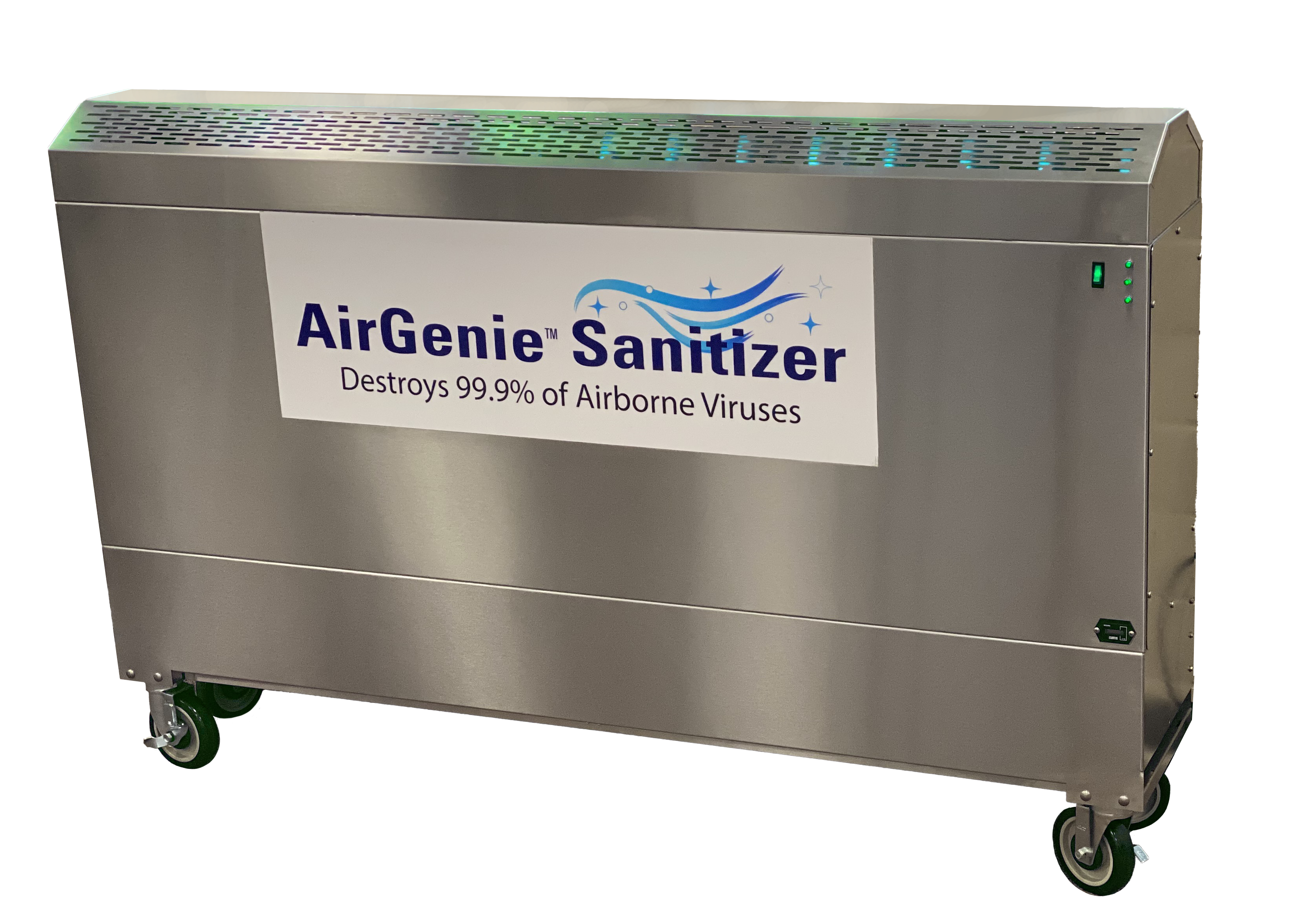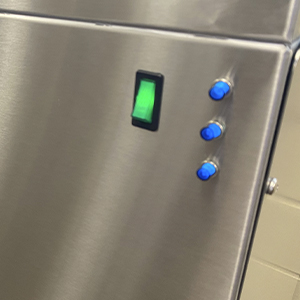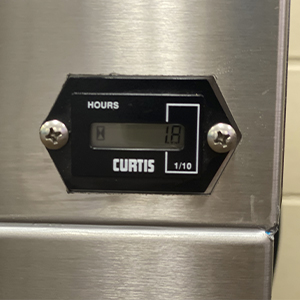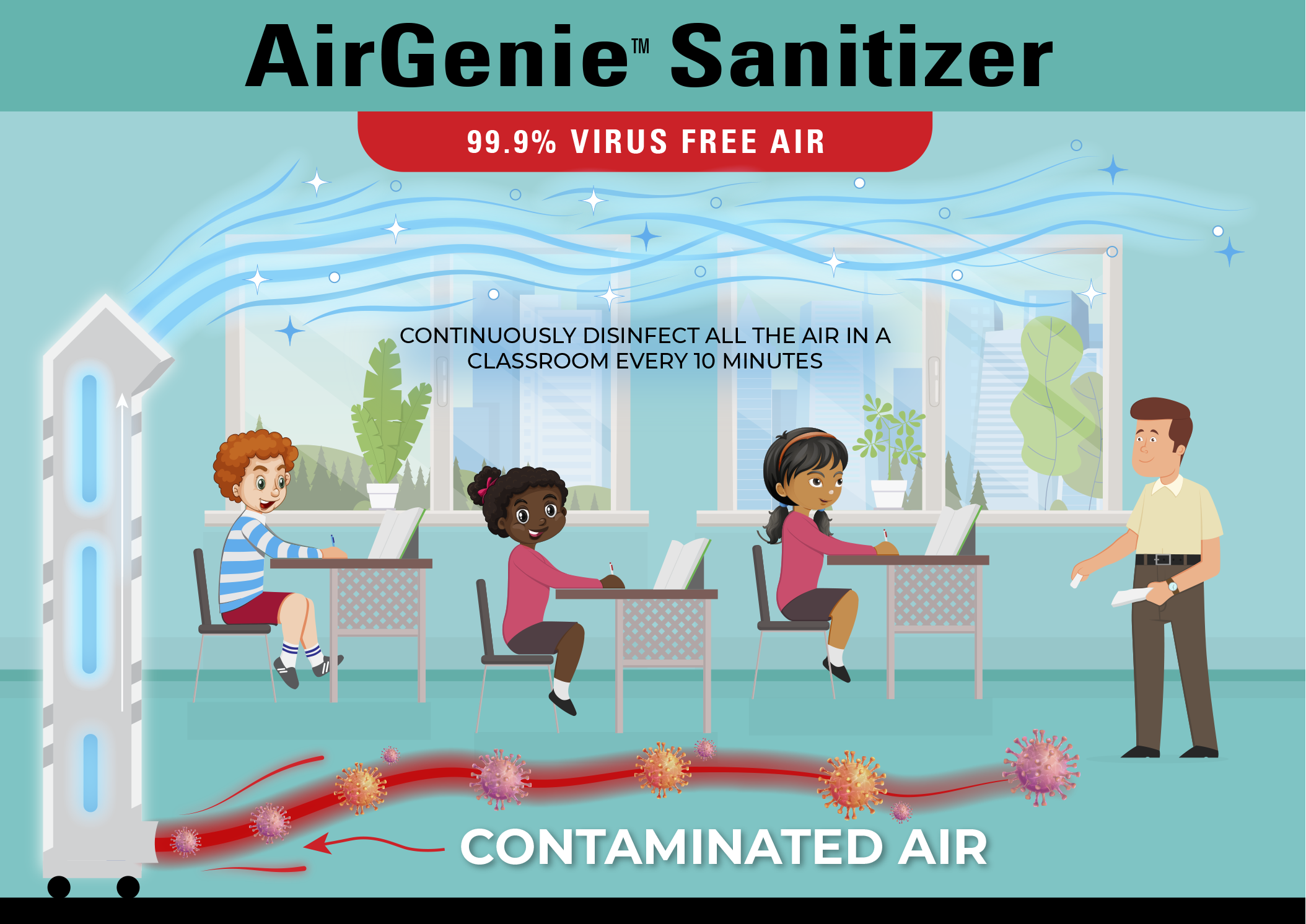AirGenie™
Sanitizer
UV-C Air Purifier
Eliminates 99.9% of Airborne Viruses


The Air Genie™ Air Sanitizer is a portable, compact disinfection device designed to eliminate harmful airborne viruses such as SARS-CoV-2 (COVID-19) from the air. The AirGenie™ is equipped with Ultra-Violet (UV-C) lights that sanitize 100% of the air in a room every 10-minutes and eliminate 99.9% of viruses.
AirGenie™ Air Sanitizer Features and Benefits

- Patent Pending UVC design for virus destruction in aerosolized droplets
- High volume low speed air flow for maximum effectiveness and comfort
- Multidirectional airflow for greater distribution of sanitized air
- Heavy-duty stainless steel and aluminum construction
- Dimensions: 64”L x 15”D x 43.5″HT Compact design compared to other air sanitizers and air purifiers in the market
- Designed with K-12 classrooms in mind
- Ozone free UVC at 254 Nanometer wavelength that is proven highly lethal to virus and bacteria
- Designed for consistent air purification in occupied spaces (e.g. Offices, Classrooms, Restaurants, etc.)
- Quiet operation: 50-52 decibels
- UV Lamps with 10,000 hours life = 6.9 years in typical classroom setting
- Made in the USA
Light Sensors
Indicates UVC bulb status

Hour Counter
Displays bulb and filter lifespan

Have more questions? Click the button below to get in contact with an expert.
How the Air Genie™ Sanitizer / Air Purifier Works
Why the AirGenie™ Sanitizer does its Best Work in Classroom and Office Settings
The Air Genie™ is specifically designed for use where the virus is released to prevent cross-contamination and spreading thru an entire building. The Air Genie™ creates a downward flow of aerosolized particles away from occupants. Sanitized air is circulated from overhead all within the same room.

The AirGenie™ Air Sanitizer is equipped with UV-C lights that are lethal to the Coronavirus (COVID-19)
“The COVID-19 pandemic caused by SARS-CoV-2 has invoked widespread interest in effective and reliable disinfection methods to help combat the virus, including ultraviolet germicidal inactivation (UVGI). Due to the novelty of this coronavirus strain at the time of writing, there are significant gaps in literature on the UV susceptibility of the pathogen. In this paper, estimates of the SARS-CoV-2 UVGI response are derived from studies reporting UV susceptibility of SARS-CoV-1, a close genomic relative. To motivate this comparison, the genome sequences of both coronavirus strains were analyzed and found to have effectively identical theoretical UV-C susceptibility, differing by only 1.48%. Conducting a curve fitting analysis on SARS-CoV-1 survivorship data obtained from existing literature, the approximate UV-C dosage required to inactivate the virus below assay limit of detection was found to be 36144 J/m 2 (≥5-log). Using this dosage as a benchmark for UVGI applications against SARS-CoV-2, a benchmark minimum exposure time can be determined by t ≈ (1.5 × 10 6)π · (r 2 /P), where r is the distance from the UV-C source to the sample surface, P is the wattage of the germicidal bulb, and t is expressed in seconds. This amounts to at least 2 hours for a 15 W UV-C bulb placed 6 inches from a disinfecting surface.”
Arguelles, Paolo. (2020). Estimating UV-C Sterilization Dosage for COVID-19 Pandemic Mitigation Efforts. 10.13140/RG.2.2.12837.65761.
The Importance of having an AirGenie™ Air Sanitizer
239 Experts With One Big Claim: The Coronavirus Is Airborne
Ventilation systems in schools, nursing homes, residences and businesses may need to minimize recirculating air and add powerful new filters. Ultraviolet lights may be needed to kill viral particles floating in tiny droplets indoors.
World Heath Organization
An aerosol is a respiratory droplet so small it may linger in the air. In its latest description of how the virus is spread, the agency said transmission of the virus by aerosols may have been responsible for “outbreaks of Covid-19 reported in some closed settings, such as restaurants, nightclubs, places of worship or places of work where people may be shouting, talking or singing.”
Spread of Delta variant marks ‘most dangerous’ time in pandemic for kids, may force schools to re-up safety measures, experts say.
The highly contagious Delta COVID variant quickly spreading through the U.S. may force schools to double down on mitigation
measures in order to reopen safely later this summer and into the fall, health experts say. It’s “one of the most dangerous
time periods [in the pandemic] for people who aren’t vaccinated,” said Taylor Nelson, a University of Missouri medical doctor
specializing in infectious disease. That includes large numbers of young people, she said.
The Centers for Disease Control and Prevention
On Wednesday expanded how it defines a “close contact” of someone with Covid-19 as it released new evidence showing
the coronavirus can be passed during relatively brief interactions. Previously, the CDC described a close contact as someone
who spent 15 minutes or more within six feet of someone who was infectious. Now, the agency says it’s someone who spent
a cumulative 15 minutes or more within six feet of someone who was infectious over 24 hours, even if the time isn’t consecutive,
according to an agency spokesperson.
Guidance for COVID-19 Prevention in K-12 Schools
CDC recommends universal indoor masking for all teachers, staff, students, and visitors to K-12 schools, regardless of vaccination status. Children should return to full-time in-person learning in the fall with layered prevention strategies in place. Students benefit from in-person learning, and safely returning to in-person instruction in the fall 2021 is a priority.

